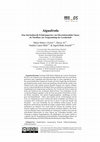Books by Natàlia Cantó Milà
Papers by Natàlia Cantó Milà
L' Avenç: Revista de història i cultura, 2017
L'estacio de Portbou de Jordi Carrio i Manel Esclusa, publicat per Cubert, es un llibre de po... more L'estacio de Portbou de Jordi Carrio i Manel Esclusa, publicat per Cubert, es un llibre de poemes i fotografies que, a partir d'un indret desolat i indissolublement lligat a Walter Benjamin, proposa una reflexio sobre Europa i allo que les fronteres representen avui.
Aquesta comunicacio es nodreix de l’analisi de 140 entrevistes autobiografiques realitzades al ll... more Aquesta comunicacio es nodreix de l’analisi de 140 entrevistes autobiografiques realitzades al llarg de deu anys a Saxonia i Catalunya (2006-2016). La seva principal hipotesi es que les memories emocionals tenen un paper estructurador i dotador de coherencia dels relats autobiografics (obtinguts en situacio d’entrevista amb una sociologa) i que, alhora, hi ha diferencies (i eixos de desigualtat) molt importants en la socialitzacio dels entrevistats que fan que uns tinguin la practica del relat autobiografic molt habitualitzat i d’altres gens. Aquestes diferencies son sobretot destacables a l’hora d’enfrontar-se amb les memories emocionals que abans esmentava (Hochschild, 1984) i alhora de formular locucions emotives (Reddy, 2001 i Austin 1962).
Papers, Oct 1, 2000
Un i versitat de Bielefeld. Alemània Re s u m L ' a rticle presenta les línies mestres de l'obra ... more Un i versitat de Bielefeld. Alemània Re s u m L ' a rticle presenta les línies mestres de l'obra de Simmel: La Filosofia del diner tot situant històricament aquesta obra i el seu autor. Els arguments principals d'aquest gran clàssic de la sociologia són exposats per tal de mostrar el caràcter novedós de l'aportació de Si m m e l. Paraules clau: Simmel, Filosofia del diner.

Acta Sociologica, 2003
It is difficult to get to understand the social work of Georg Simmel, overall his analysis of the... more It is difficult to get to understand the social work of Georg Simmel, overall his analysis of the value and consequences of the money as well as their diagnosis of the modern age, without considering his critical reading of Karl Marx. In fact, Simmel presented its monograph Philosophy of the money as answer and complement of the Marxist historical materialism. Thus, its intention was not to be divergent of the line of thought propose by Karl Marx but to enrich it through an extension of its perspective of analysis. This article proposes, on the one hand, to compare the Marxist and Simmelian analysis of the capitalist society (monetary) and thus to clarify the lines of continuity and spacing between both authors. On the other hand, is analyzed the Simmel's reading of the work of Marx, standing out the aspects which Simmel could not know. Also the long discussion of the theory of the Marxist value is emphasized, to which Simmel dedicated special attention in Philosophy of the money.
Papers. Revista de Sociologia, 2000
Un i versitat de Bielefeld. Alemània Re s u m L ' a rticle presenta les línies mestres de l'obra ... more Un i versitat de Bielefeld. Alemània Re s u m L ' a rticle presenta les línies mestres de l'obra de Simmel: La Filosofia del diner tot situant històricament aquesta obra i el seu autor. Els arguments principals d'aquest gran clàssic de la sociologia són exposats per tal de mostrar el caràcter novedós de l'aportació de Si m m e l. Paraules clau: Simmel, Filosofia del diner.

Acta Sociologica, 2003
It is difficult to get to understand the social work of Georg Simmel, overall his analysis of the... more It is difficult to get to understand the social work of Georg Simmel, overall his analysis of the value and consequences of the money as well as their diagnosis of the modern age, without considering his critical reading of Karl Marx. In fact, Simmel presented its monograph Philosophy of the money as answer and complement of the Marxist historical materialism. Thus, its intention was not to be divergent of the line of thought propose by Karl Marx but to enrich it through an extension of its perspective of analysis. This article proposes, on the one hand, to compare the Marxist and Simmelian analysis of the capitalist society (monetary) and thus to clarify the lines of continuity and spacing between both authors. On the other hand, is analyzed the Simmel's reading of the work of Marx, standing out the aspects which Simmel could not know. Also the long discussion of the theory of the Marxist value is emphasized, to which Simmel dedicated special attention in Philosophy of the money.

European journal of social theory, Mar 21, 2024
This article introduces a relational approach to studying imaginaries of the future, emphasising ... more This article introduces a relational approach to studying imaginaries of the future, emphasising their significance in comprehending present realities and the ongoing processes that interweave our social fabric. It posits ‘imaginaries of the future’ as a pivotal sociological concept for understanding the reciprocal social influences and uneven structural dynamics shaping the present. This work engages in a theoretical discourse, spotlighting the role of the future in contemporary social landscapes, while endorsing the suitability of the concept of imaginaries to elucidate how we collectively interlace our present through implicit dialogues with latent, emergent futures and glimpses of radical imagination. In this article, we advocate for sociological research on ‘imaginaries’, discussing the concept’s relevance to sociological theory and research. In addition, we make a case for examining futures as a subject of sociological research. Finally, we propose a conceptual framework for analysing imaginaries of the future from a relational sociological perspective, fostering interdisciplinary dialogue.

This article introduces a relational approach to studying imaginaries of the future, emphasising ... more This article introduces a relational approach to studying imaginaries of the future, emphasising their significance in comprehending present realities and the ongoing processes that interweave our social fabric. It posits ‘imaginaries of the future’ as a pivotal sociological concept for understanding the reciprocal social influences and uneven structural dynamics shaping the present. This work engages in a theoretical discourse, spotlighting the role of the future in contemporary social landscapes, while endorsing the suitability of the concept of imaginaries to elucidate how we collectively interlace our present through implicit dialogues with latent, emergent futures and glimpses of radical imagination. In this article, we advocate for sociological research on ‘imaginaries’, discussing the concept’s relevance to sociological theory and research. In addition, we make a case for examining futures as a subject of sociological research. Finally, we propose a conceptual framework for analysing imaginaries of the future from a relational sociological perspective, fostering interdisciplinary dialogue.

espanolEl dosier de este numero de Digithum gira en torno al arte y concretamente en torno a las ... more espanolEl dosier de este numero de Digithum gira en torno al arte y concretamente en torno a las relaciones sociales que lo hacen posible y, a su vez, de las relaciones sociales que el arte mismo nos ayuda a crear, mantener y llenar de sentido. Es por ello por lo que hemos optado por el titulo «En relacion con el arte. El arte desde una perspectiva relacional». El arte –ya sea la musica, la performance, el teatro, la pintura, la escultura, una coleccion de munecas o de instrumentos antiguos, etc. y todo nuestro esfuerzo por vincularnos con la memoria que acarrean y con las experiencias que nos ofrecen– nace de nuestras relaciones y de nuestra creacion conjunta de una forma de vivir, de mirar, de escuchar y de dar sentido a este arte. Por esto, Digithum intenta en esta ocasion aproximarse al mundo del arte, a sus fronteras y a su experiencia, a partir del conjunto de relaciones que lo hacen posible y que el arte mismo hace posibles. catalaEl dossier de Digithum d’enguany gira entorn de l’art i concretament entorn de les relacions socials que el fan possible i, alhora, de les relacions socials que l’art mateix ens ajuda a crear, mantenir i omplir de sentit. Es per aixo que hi hem posat com a titol «En relacio amb l’art. L’art des d’una perspectiva relacional». L’art –sigui la musica, la performance, el teatre, la pintura, l’escultura, una col·leccio de nines o d’instruments antics, etc. i tot el nostre esforc per vincular-nos amb la memoria que transporten i amb les experiencies que ens ofereixen– neix de les nostres relacions i de la nostra creacio conjunta d’una forma de viure’l, de mirar-lo, d’escoltar-lo i de donar-hi sentit. Es per aixo que aquest numero de Digithum intenta acostar-se al mon de l’art, les seves fronteres i la seva experiencia, a partir del conjunt de relacions que el fan possible i que l’art mateix fa possibles. EnglishDigithum is publishing its 17th issue, on this occasion devoted to the field of art and especially to the social relations that make art possible and which at the same time, are made possible (crystallised and filled with meaning) by art. It is for this reason that this issue has been titled “In Relation to Art - Art from a Relational Perspective.” Art, be it in the form of music, performance, theatre, painting, sculpture, a collection of dolls or of ancient tools... and with these all the congealed efforts to link us to memories which art pieces carry and experiences they offer, is a product of our relations and of our joint creation of forms. Social relations come into existence by experiencing, looking at, and listening to, art, thus filling the artwork with meaning. Thus Digithum seeks to focus on the system of art, from its porous boundaries to its purest experience, by reflecting on the relations that make art possible and that art calls into existence.
Papers Revista De Sociologia, 2000
L ' a rticle presenta les línies mestres de l'obra de Simmel: La Filosofia del diner tot ... more L ' a rticle presenta les línies mestres de l'obra de Simmel: La Filosofia del diner tot situant històricament aquesta obra i el seu autor. Els arguments principals d'aquest gran clàssic de la sociologia són exposats per tal de mostrar el caràcter novedós de l'aportació de Si m m e l

Im Januar 2019 fand im Rahmen des Vereins ZUsammenKUNFT eine Exkursion des Oberstufen-Kollegs Bie... more Im Januar 2019 fand im Rahmen des Vereins ZUsammenKUNFT eine Exkursion des Oberstufen-Kollegs Bielefeld (OS) mit zwölf Kollegiat*innen nach Aiguafreda nahe Barcelona statt. Es waren Jugendliche, die aus den unterschiedlichsten Gründen als Fremde, als Nicht-Zugehörige der Dominanzgesellschaft gesehen wurden. Durch den räumlichen Abstand und die Lektüre eines Simmel-Textes sollte anhand zentraler Begriffe Simmels eine Analyse erfolgen, um die Lebenswirklichkeit der Kollegiat*innen zu reflektieren und Kategorien von Zugehörigkeit und Ausgrenzung zu erkennen. Der Transfer der Theorie ergab sich durch das Zelebrieren des yezidischen Batizmi-Festes. Eine Kollegiatin, die der yezidischen Religion angehört, wollte als Ersatz der großen Familienfeier ein kleines Ritual veranstalten. Alle anderen Gruppenmitglieder– unabhängig von Religion und Herkunftsland – ließen sich komplett auf die Vorbereitungen und die Feier ein. In Folge dessen waren wirklich alle damit beschäftigt, nach Deryas Anweis...

Cuadernos de Teoría Social, Sep 1, 2020
Este artículo, fruto de una investigación sobre los “Imaginarios de futuro de los jóvenes”, se ce... more Este artículo, fruto de una investigación sobre los “Imaginarios de futuro de los jóvenes”, se centra en los futuros que los jóvenes no desean tener que vivir. El objetivo del presente texto es, por tanto, un análisis de los futuros (explícitamente) no deseados. Para realizar esta investigación y elaborar un mapa relacional de los futuros no deseados de los jóvenes entre 15 y 18 años, hemos trabajado colaborativamente con tres centros de enseñanza pública secundaria de la provincia de Barcelona (uno de ellos en la misma Barcelona capital y dos en poblaciones de entre 6000 y 10000 habitantes). En este artículo nos centramos en las respuestas de los jóvenes a la pregunta, vehiculada en el aula por sus propios profesores, sobre qué no les gustaría que (les) pasase en el futuro. Estas respuestas se han recogido de forma anonimizada y codificado en Atlas.ti, siguiendo las tres fases de codificación especificadas por Strauss y Corbin (1997). Finalmente, hemos trazado relacionalmente un mapa de futuros no deseados que nos servirá de guía y base para el análisis en el que diferenciamos los imaginarios individuales de fracaso de los imaginarios colectivos de pérdida.











Uploads
Books by Natàlia Cantó Milà
Papers by Natàlia Cantó Milà